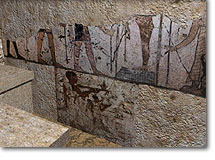Between 1977 and 1978 the excavations at Kom Madi, located about one kilometer from Medinet Madi in the Fayum, revealed among other interesting buildings a chapel of dynastic worship. The chapel built with raw bricks it is important for the scenes of the wall paintings, remarkable and without any parallel so far, that decorate the walls of the courtyard and the sacellum, to be dated around I century B.C. The paintings of the cell are typically Egyptian and show Osiri at the bottom, with the goddesses Isis and Nefti on his side, above a clinè in raw bricks and an altar; (they also show) the figure of an officiant and that of the breeding of Thot’s sacred Ibis, fed by an attendant (ibioboskos), and the presentation of the cult chapel owner in front of various Egyptian deities.

The court’s walls are decorated with very original themed paintings in the Greek-Egyptian style; at the right of the door, on top of a wreathed horns altar the Libatore pouring wine, while an officiant performs the sacrifice of a red bull; at the left of the door, the theme of Pharaoh Horo’s victory over the enemy; on the east wall of the court, the chariot of the solar deity pulled by winged panthers chasing desert animals, a gazelle and an antelope; a military parade which accompanies an eminent figure, wearing a long robe decorated with embroidery and precious stones; the scene was painted on a wall found collapsed, whose fragments carefully recomposed allowed to reconstruct almost completely the two registers of the painting.

The “oriental” dress of the figure, the head surrounded by a diadem, the face and the gaze raised upwards, allow to propose its identification with Alexander the Great to whom the chapel may have been dedicated for a Macedonian, heroic and dynastic cult wanted by the Ptolemies. In addition to the dynastic worship chapel, a temple for Anubis was discovered, an “Anoubieion”, and a chapel which a demotic inscription identifies as dedicated to Imhotep, god of medicine and worshiped by the Greeks as Asclepius.
